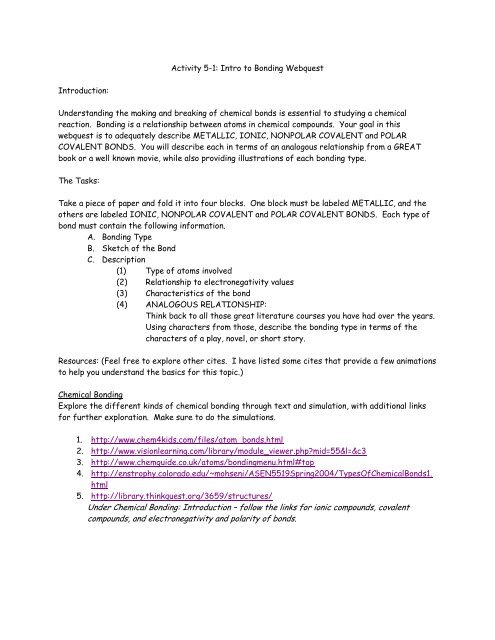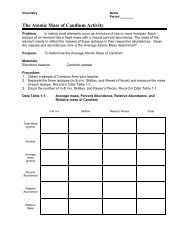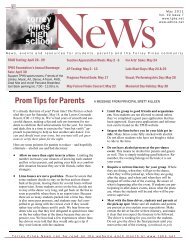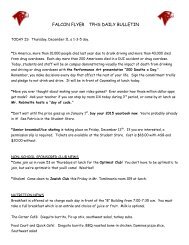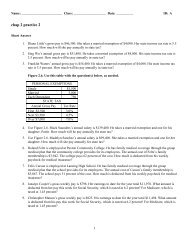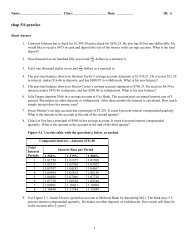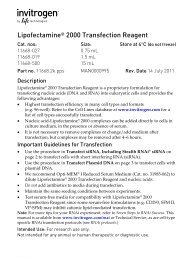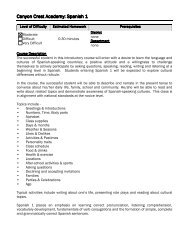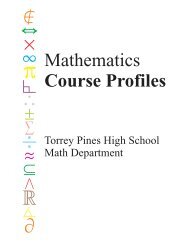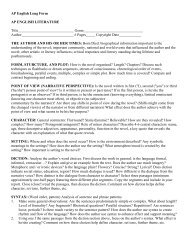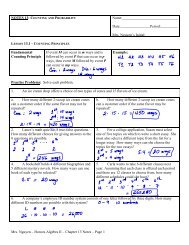Create successful ePaper yourself
Turn your PDF publications into a flip-book with our unique Google optimized e-Paper software.
Activity 5-1: <strong>Intro</strong> <strong>to</strong> <strong>Bonding</strong> Webquest<strong>Intro</strong>duction:Understanding the making and breaking of chemical bonds is essential <strong>to</strong> studying a chemicalreaction. <strong>Bonding</strong> is a relationship between a<strong>to</strong>ms in chemical compounds. Your goal in thiswebquest is <strong>to</strong> adequately describe METALLIC, IONIC, NONPOLAR COVALENT and POLARCOVALENT BONDS. You will describe each in terms of an analogous relationship from a GREATbook or a well known movie, while also providing illustrations of each bonding type.The Tasks:Take a piece of paper and fold it in<strong>to</strong> four blocks. One block must be labeled METALLIC, and theothers are labeled IONIC, NONPOLAR COVALENT and POLAR COVALENT BONDS. Each type ofbond must contain the following information.A. <strong>Bonding</strong> TypeB. Sketch of the BondC. Description(1) Type of a<strong>to</strong>ms involved(2) Relationship <strong>to</strong> electronegativity values(3) Characteristics of the bond(4) ANALOGOUS RELATIONSHIP:Think back <strong>to</strong> all those great literature courses you have had over the years.Using characters from those, describe the bonding type in terms of thecharacters of a play, novel, or short s<strong>to</strong>ry.Resources: (Feel free <strong>to</strong> explore other cites. I have listed some cites that provide a few animations<strong>to</strong> help you understand the basics for this <strong>to</strong>pic.)Chemical <strong>Bonding</strong>Explore the different kinds of chemical bonding through text and simulation, with additional linksfor further exploration. Make sure <strong>to</strong> do the simulations.1. http://www.chem4kids.com/files/a<strong>to</strong>m_bonds.html2. http://www.visionlearning.com/library/module_viewer.php?mid=55&l=&c33. http://www.chemguide.co.uk/a<strong>to</strong>ms/bondingmenu.html#<strong>to</strong>p4. http://enstrophy.colorado.edu/~mohseni/ASEN5519Spring2004/TypesOfChemicalBonds1.html5. http://library.thinkquest.org/3659/structures/Under Chemical <strong>Bonding</strong>: <strong>Intro</strong>duction – follow the links for ionic compounds, covalentcompounds, and electronegativity and polarity of bonds.
Metallic <strong>Bonding</strong>6. http://dl.clackamas.cc.or.us/ch104-08/metallic.htm7. http://www.chemguide.co.uk/a<strong>to</strong>ms/bonding/metallic.htmlIonic <strong>Bonding</strong>8. http://www.tu<strong>to</strong>rvista.com/content/chemistry/chemistry-i/chemical-bonding/ioniccompounds.php9. http://www.tu<strong>to</strong>rvista.com/content/chemistry/chemistry-i/chemical-bonding/ionicbonding-animation.phpCovalent <strong>Bonding</strong>How does electron sharing bond a<strong>to</strong>ms? What are valence electrons? What is polarity? Are theresimilarities between covalent and ionic bonds? This site answers these questions and many more.10. http://chemed.chem.purdue.edu/genchem/<strong>to</strong>picreview/bp/ch8/valenceframe.htmlA<strong>to</strong>mic Structure and <strong>Bonding</strong>Understanding the making and breaking of chemical bonds is essential <strong>to</strong> studying a chemicalreaction. A good introduction <strong>to</strong> basic bonding.11. http://www.chem.ox.ac.uk/vrchemistry/electronsandbonds/intro1.htmGo through pages 1 and 2 of the introduction12. http://www.tu<strong>to</strong>rvista.com/content/chemistry/chemistry-i/chemical-bonding/covalentbond-animation.phpNote that on the right bot<strong>to</strong>m you can also select the various types of covalent bonds.Evaluation:DescriptionArtAnalogyPresentationLinus Pauling BS Chemist Joe AverageThe bond description iscomplete and detailed.Beautiful.The instruc<strong>to</strong>rwill hang on hisrefrigera<strong>to</strong>r.The literary reference isappropriate and wellknown.Your group presents yourposter in outstandingfashion.The bond descriptionlacks specific details.Your mother loves it andposts it in the living room.The analogy pertains <strong>to</strong>relationships betweenfamily, friends, or generic.Your group does not detailyour discoveries oranalogies.The description containserrors, or is very lackingin detail.Lacks, or creative detail.The analogy is incorrect,or not descriptive of thebond.Your group shows youposter and sits down.Conclusions: On the completion of this project the student will understand bonding and assimilate the terminology in<strong>to</strong> theirvocabulary. It is the hope that through this activity students will have a complete and detailed view of chemical bonding.


